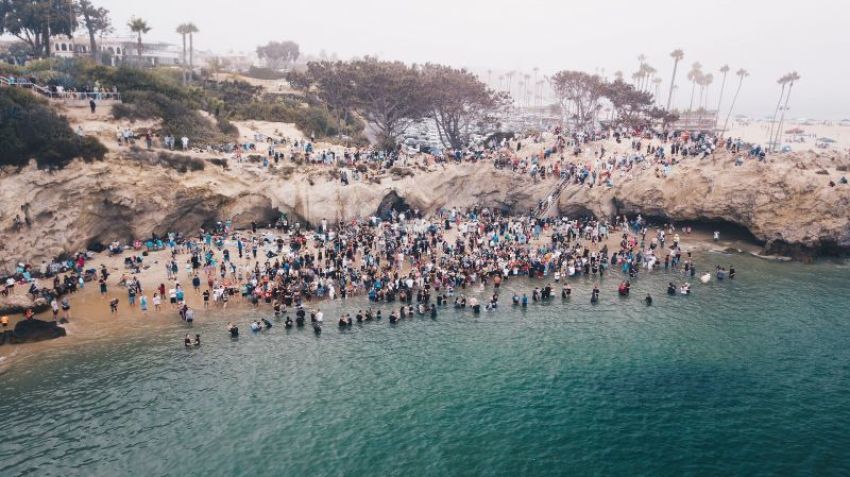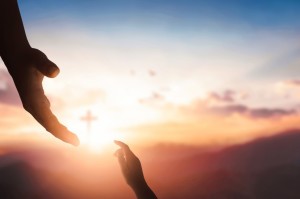Do you want a revolution? The 60s and 70s Jesus Movement then and now

It’s 1970.
Google Earth doesn’t yet exist, but imagine that it does. You are in outer space. The earth is a round, blue marble. Then you zoom in on the map of the United States, the West Coast, Southern California. You see the dark blue waters of the Pacific Ocean, and as you get closer, you see the long ribbon of the Pacific Coast Highway, the beach towns south of Los Angeles, the furrows of the waves. You see the slender strip of land called the Balboa Peninsula, and you draw close to Corona del Mar. There is the beach, dotted with fire pits. There is an outcropping of cliffs that form a natural amphitheater near the mouth of the harbor. The rocks look wrinkled at this height. The sun is setting.
As you get closer, you see that there is a huge crowd massing the area. At first the people look like ants. They’re perched on the rocks, sitting on the sand, standing in the shallows of the rolling water. They have their arms around each other. They seem to be singing.
Now you are close enough to the beach to hear the music. There are simple choruses and haunting, melodic harmonies. Something about “one in the Spirit, one in the Lord.” The setting looks like a baptismal scene from the New Testament except for the cutoff shorts of slender teenagers, most with long hair parted in the middle; some are shivering, sharing a striped towel. A bearded pastor in a flowing tunic, sopping wet, dunks a young man down in the cold water for a long moment. It’s as if he’s been buried.
Then the hippie pastor raises the kid up, and the teenager bursts out of the sea, water streaming from his face and hair and shoulders. The first thing he gasps, though, is strange: “I’m alive!”
The hippies who plunged into the Pacific Ocean during that summer sunset in 1970 didn’t know they were in a revival. They didn’t know even what a revival was. But thanks to the Beatles, Jim Morrison, and other countercultural icons of the day, the hippies did know about words like revolution. It swelled among young people—the baby boomer generation—in the US from the late 1960s into the early 1970s and it was called the Jesus Revolution or Jesus Movement by national magazines which featured stories about this mass spiritual phenomenon, as did newspapers like the New York Times. More people were baptized during the Jesus Revolution than in any time since people started keeping records. The churches that welcomed the hippies grew in grace and vigor; the ones that didn’t miss both the boat and the blessing.
Today there’s a growing sense that history has run one of its cycles, and we’re back in ’60s mode. Like the hippies, millennials—people born between the early 1980s and the early 2000s—say they are hungry for authenticity, a sense of community, and real care for people who are needy and marginalized.
Like the hippies, they’re a bit cynical about big business, big institutions, or organized religion. Bombarded by competing content online for most of their lives, they shy away from advertising, causes, or techniques that feel superficially targeted toward them. They gravitate toward “user-generated content” that feels like it came from a real person, not a brand.
Meanwhile, their phones ping with news alerts all the time, feeding a generalized anxiety about racial unrest, environmental sustainability, gender issues, terrorism and long-range missiles. Issues like sex trafficking, genocide, starvation, and natural disasters are on their screens and in their faces all the time.
The old baby boomers were the first generation to see body bags coming back from Vietnam on the evening news. Today, we see mass murders at concerts, nightclubs, churches, and everywhere else in real time. We’re all on edge. There’s another harsh parallel with the ’60s. After the hopeful, peaceful civil rights marches of the ’60s came the assassinations of Martin Luther King Jr. and Robert Kennedy. There were riots in the streets. Similarly, Time magazine called the streets of Baltimore, Ferguson, and other racially charged cities a scene from 1968. On the political front, it’s safe to say that we’ve lost the ability to have civil discourse among those who hold different points of view and the national “conversation,” if you can call it that, has never been uglier.
Spiritually, many young people are fed up with conventional church. Today, 75 percent of young people who grew up in Christian homes and churches are now abandoning their faith as young adults. The seeker-friendly megachurches of their parents’ generation are too slick and programmed; they want something more real, more radical, and more rugged. They are still thirsty for transcendence. But when we portray God as a cosmic buddy, we lose them (they have enough friends). When we tell them that God will give them a better marriage and family, it’s white noise (they’re delaying marriage and kids or forgoing them altogether). When we tell them they’re special, we’re merely echoing what educators, coaches, and parents have told them their whole lives. But when we present a ravishing vision of a loving and holy God, it just might get their attention and capture their hearts as well.
This is what we all need today, young or old. In a weary, chaotic, selfie-satiated culture, we need a big, ravishing, transcendent, and transformational vision of who God really is. The hippies, flower children, and others who came to Jesus back in the ’60s were desperate. They were willing to go to any lengths, or on any trip, to find what they were looking for. They’d throw off their clothes or their conventions, longing to break free of sin and shame. And when they heard the gospel—that Jesus was real and alive and loved the whole world—it blew their minds, to put it in ’60s vernacular. Their desperate search was satisfied.
That’s what happened fifty years ago. It can happen again today.
As Isaiah 64:5 says, God meets with those who remember His ways. Telling stories of former revivals can help spark expectant hearts. After all this isn’t just about a peace-sign nostalgia fest for old baby boomers. It’s about how the wheel of faith turns, and the surprising ways in which God can make it new and fresh in our own time, for a whole new generation in search of a revolution all their own.
This article is an excerpt from “Jesus Revolution: How God Transformed an Unlikely Generation and How He Can Do It Again Today” written by Greg Laurie and Ellen Vaughn. It has been edited for publishing.



























